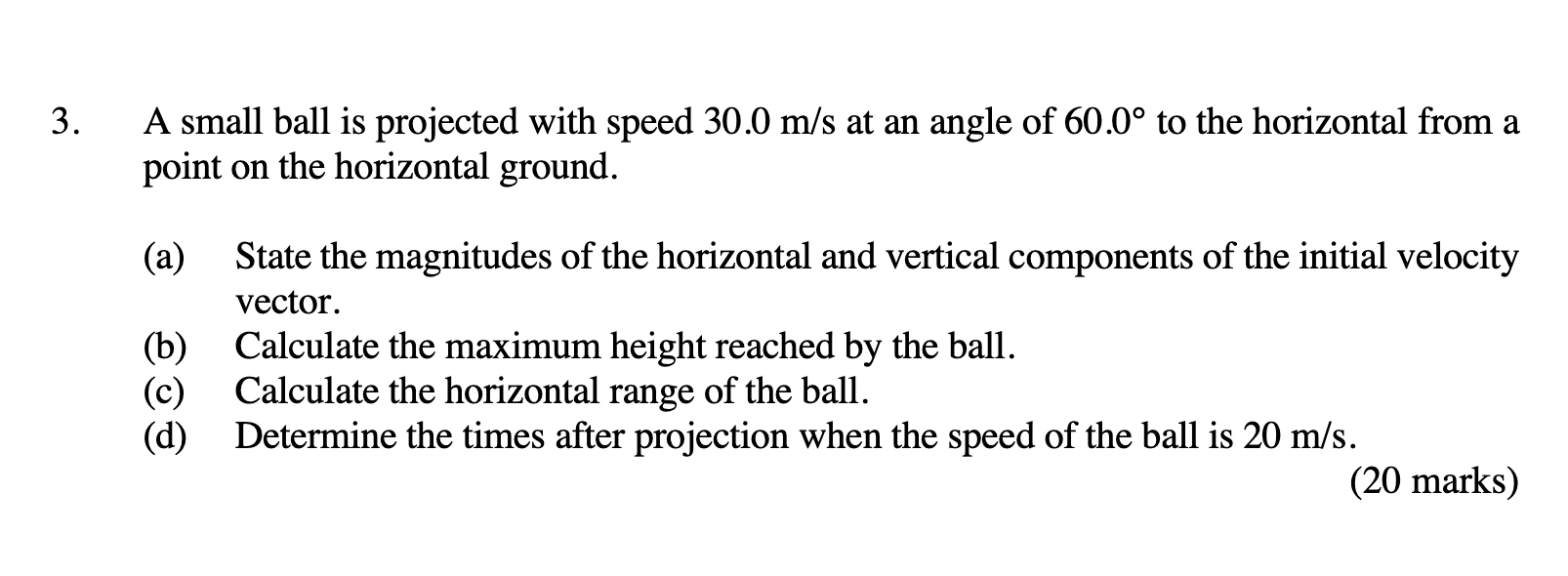A small ball is projected with speed 30.0 m/s at an angle of 60.0° to the horizontal from a point on the horizontal ground. (a) State the magnitudes of the horizontal and vertical... A small ball is projected with speed 30.0 m/s at an angle of 60.0° to the horizontal from a point on the horizontal ground. (a) State the magnitudes of the horizontal and vertical components of the initial velocity vector. (b) Calculate the maximum height reached by the ball. (c) Calculate the horizontal range of the ball. (d) Determine the times after projection when the speed of the ball is 20 m/s.

Understand the Problem
The question is about projectile motion, specifically involving a small ball projected with a given speed and angle. It requires calculations related to the horizontal and vertical components of the initial velocity, maximum height, horizontal range, and time at a specific speed.
Answer
(a) $V_{x} = 15.0 \, \text{m/s}$, $V_{y} \approx 25.98 \, \text{m/s}$. (b) $H_{max} \approx 33.2 \, \text{m}$. (c) $R \approx 88.5 \, \text{m}$. (d) $t \approx 2.06 \, \text{s}$ and $t \approx 6.94 \, \text{s}$.
Answer for screen readers
(a) Horizontal component: $V_{x} = 15.0 , \text{m/s}$; Vertical component: $V_{y} \approx 25.98 , \text{m/s}$.
(b) Maximum height: $H_{max} \approx 33.2 , \text{m}$.
(c) Horizontal range: $R \approx 88.5 , \text{m}$.
(d) Times when speed is 20 m/s: $t \approx 2.06 , \text{s}$ and $t \approx 6.94 , \text{s}$.
Steps to Solve
- Finding the Horizontal Component of Velocity
To find the horizontal component ($V_{x}$) of the initial velocity, we use the formula: $$ V_{x} = V \cdot \cos(\theta) $$ where $V$ is the initial speed (30.0 m/s) and $\theta$ is the angle (60°).
- Finding the Vertical Component of Velocity
Next, we calculate the vertical component ($V_{y}$) of the initial velocity using: $$ V_{y} = V \cdot \sin(\theta) $$ Substituting in the values: $$ V_{y} = 30.0 \cdot \sin(60°) $$
- Calculating Maximum Height
The maximum height ($H_{max}$) reached by the ball is calculated using the formula: $$ H_{max} = \frac{V_{y}^2}{2g} $$ where $g$ is the acceleration due to gravity (approximately 9.81 m/s²). We will substitute $V_{y}$ found previously into this formula.
- Calculating Horizontal Range
The horizontal range ($R$) can be determined using: $$ R = \frac{V_{x} \cdot T}{g} $$ where $T$ is the total time of flight, which can be calculated as: $$ T = \frac{2V_{y}}{g} $$
- Finding Time When Speed is 20 m/s
Finally, to determine the times after projection when the speed of the ball is 20 m/s, we use the kinematic equation: $$ v^2 = V^2 + 2a d $$ We will rearrange this equation to find the time at which the speed equals 20 m/s, considering horizontal and vertical components.
(a) Horizontal component: $V_{x} = 15.0 , \text{m/s}$; Vertical component: $V_{y} \approx 25.98 , \text{m/s}$.
(b) Maximum height: $H_{max} \approx 33.2 , \text{m}$.
(c) Horizontal range: $R \approx 88.5 , \text{m}$.
(d) Times when speed is 20 m/s: $t \approx 2.06 , \text{s}$ and $t \approx 6.94 , \text{s}$.
More Information
In projectile motion, the horizontal and vertical motions are independent of each other. The maximum height occurs when the vertical velocity becomes zero, and the range can be calculated from the time of flight and horizontal component of velocity.
Tips
- Confusing the horizontal component with the vertical component; make sure to use the correct trigonometric functions.
- Forgetting to convert angles to radians when using tools that require radian measures.
- Not accounting for gravity when calculating the max height and time of flight.
AI-generated content may contain errors. Please verify critical information